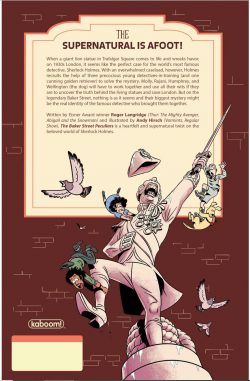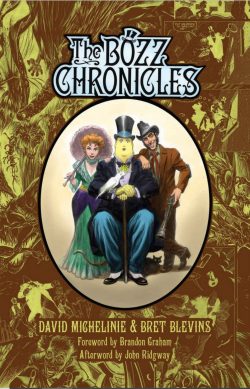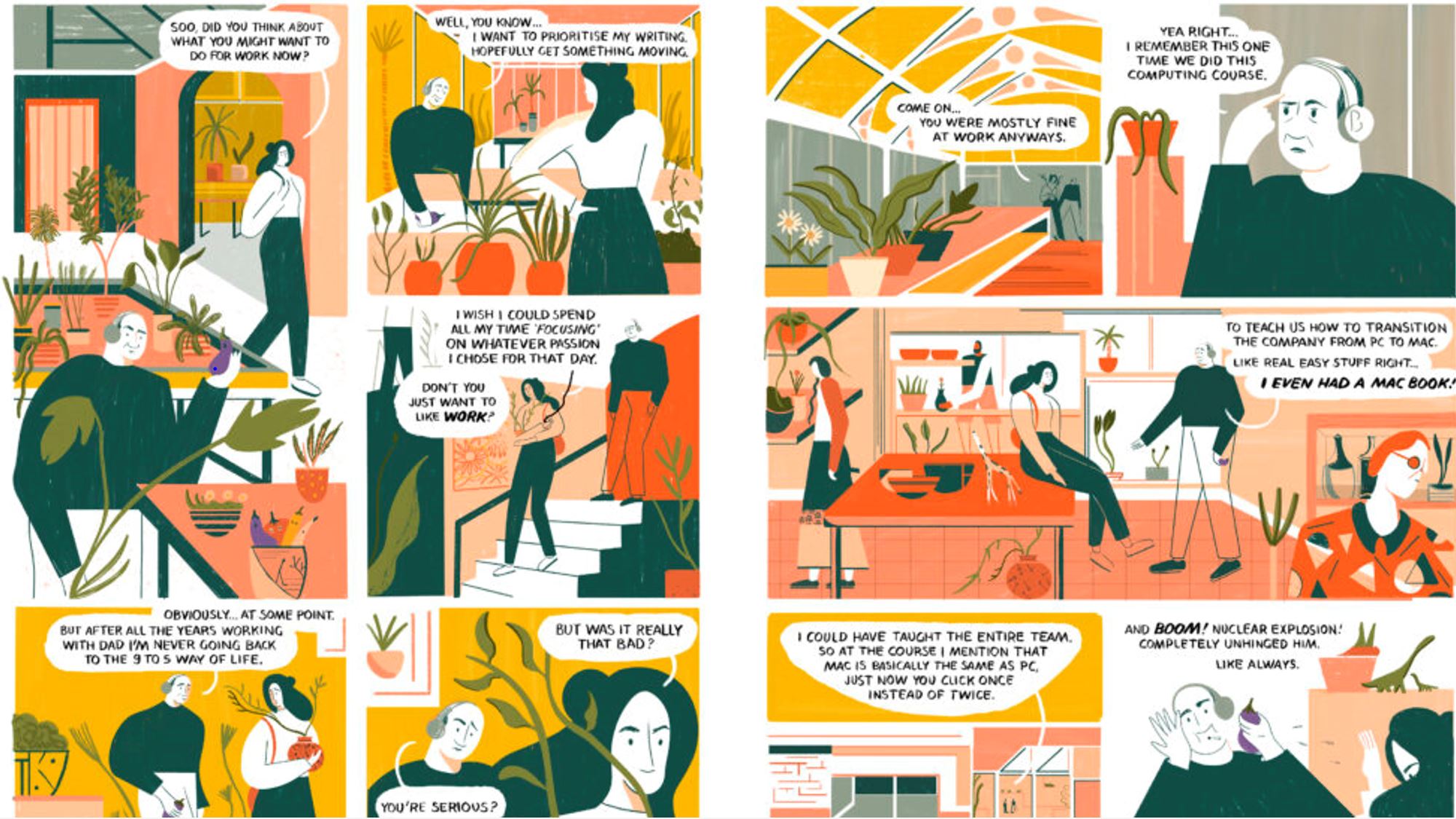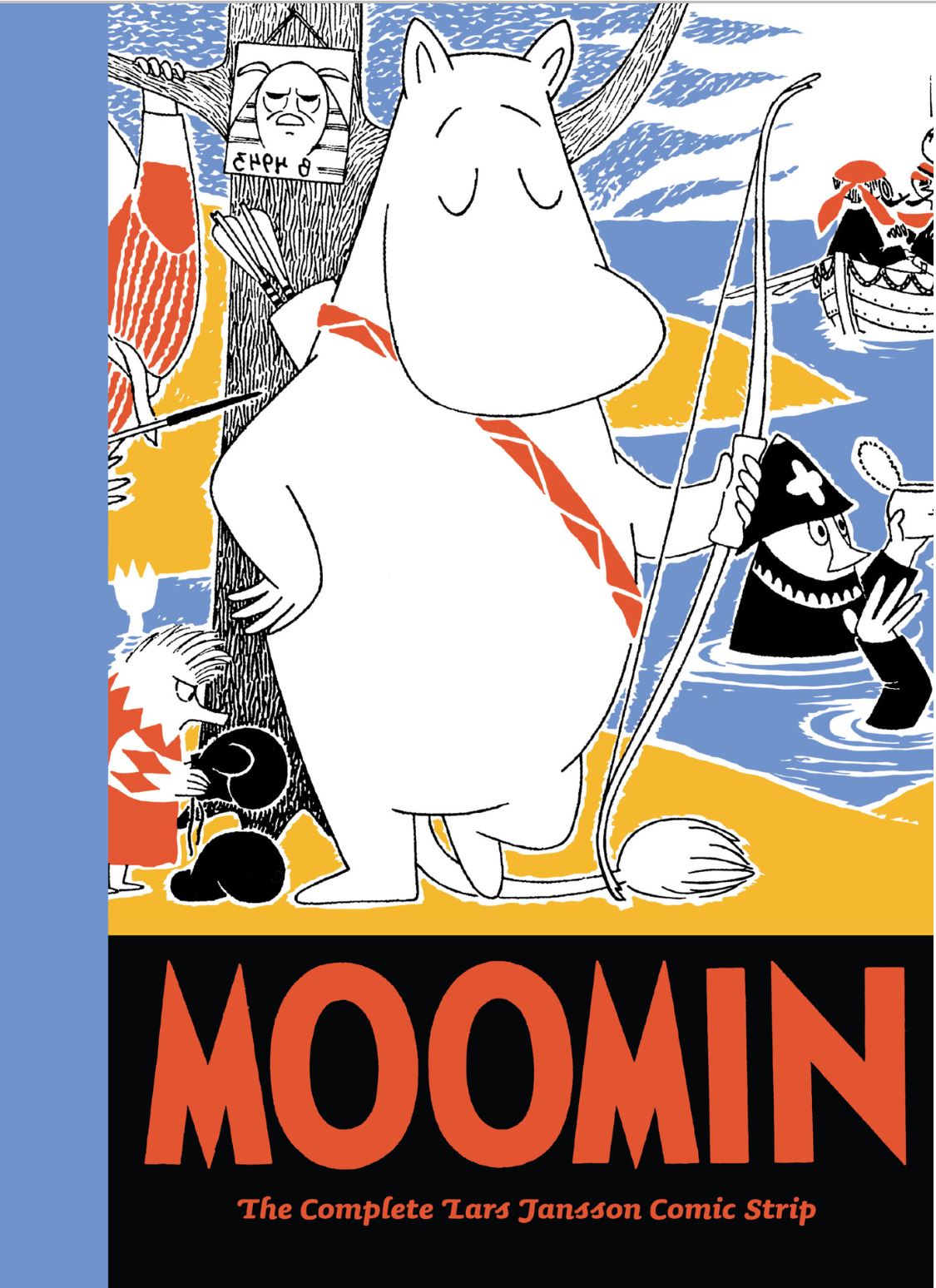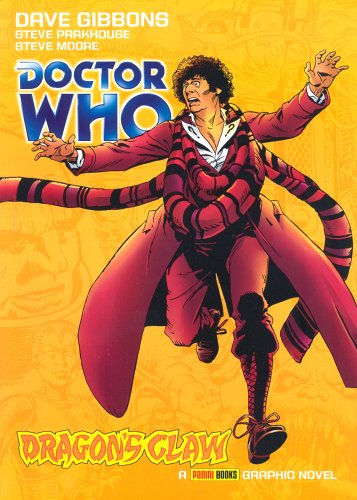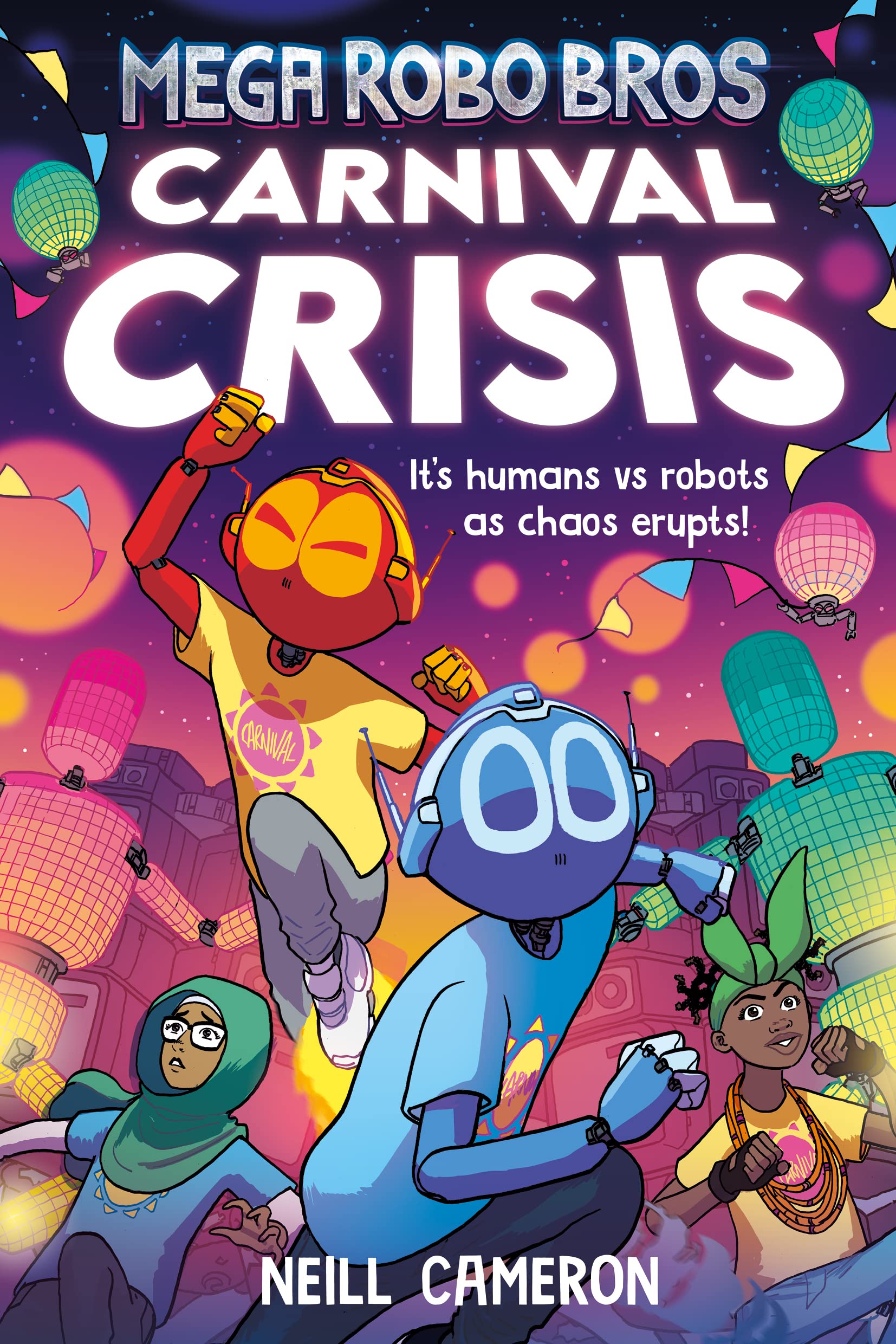
By Neill Cameron, with Austin Baechle (David Fickling Books)
ISBN: 978-1-78845-298-4 (TPB)
Mighty in metal and potent in plastic, here’s the latest upgrade in a sterling, solid gold all-ages sci fi saga from Neill (Tamsin of the Deep, Pirates of Pangea, How to Make Awesome Comics, Freddy) Cameron. Perfect purpose-built paladins, the mecha-miraculous Mega Robo Bros find that even they can’t fight punch out intolerance or growing pains in these electronic exploits balancing frantic fun with portents of darker, far more violent days to come…
It’s still the Future!
In a London far cooler but just as embattled as ours, Alex and his younger brother Freddie Sharma are generally typical kids: boisterous, fractious, eternally argumentative yet devoted to each other, and not too bothered that they’re adopted. It’s really no big deal for them that they were meticulously and covertly constructed by the mysterious Dr. Roboticus – before he vanished – and are considered by those in the know as the most powerful – and only fully SENTIENT – robots on Earth.
Dad is just your average old guy who makes lunch and does a bit of writing (he’s actually an award-winning journalist), but when not being a housewife, Mum is pretty extraordinary herself. As surprisingly famous and renowned robotics boffin Dr. Nita Sharma she harbours some shocking secrets of her own…
Life in the Sharma household tries to be normal. Freddie is insufferably exuberant and over-confident, whilst Alex is at the age when self-doubt and anxiety hit hard. Moreover, the household’s other robot rescues can also be problematic…
Programmed as a dog, baby triceratops Trikey is ok, but eccentric French-speaking ape Monsieur Gorilla can be tres confusing, and gloomily annoying, existentialist aquatic waterfowl Stupid Philosophy Penguin hangs around ambushing everyone with quotes from dead philosophers…
The boys have part-time but increasing difficult jobs as super-secret agents, although because they weren’t very good at the clandestine part, almost the entire world now knows of them. Generally, however, it’s enough for the digital duo that their parents love them, even though they are a bit more of a handful than most kids. They all live as normal a life as possible: going to human school, playing with human friends and hating homework. It’s all part of their “Mega Robo Routine”, combining dull human activities, actual but rare fun, games-playing, watching TV and constant training in the combat caverns under R.A.I.D. HQ.
Usually, when a situation demands, the boys carry out missions for bossy Baroness Farooq: head of government agency Robotics Analysis Intelligence and Defence. They still believe it’s because they are infinitely smarter and more powerful than the Destroyer Mechs and other man-made minions she usually utilises.
Originally published in UK weekly comic The Phoenix, this revised, retooled and remastered saga opens with the lads feted as global heroes.
After defeating dangerous villains like Robot 23 and thwarting a robot rebellion sparked by artificial life activist The Caretaker, the Bros battled monstrous, deadly damaged droid Wolfram in the arctic and learned that he might be their older brother. Even so, they had to destroy him and now Alex is increasingly traumatised by the act…
Over the course of that case they learned that fifteen years previously Mum was a brilliant young roboticist working under incomparable (but weird) pioneering genius Dr. Leon Robertus. His astounding discoveries had earned him the unwelcome nickname Dr. Roboticus and perhaps that’s what started pushing him away from humanity…
Robertus had allowed Nita to repurpose his individually superpowered prototypes into a rapid-response team for global emergencies. Mum used to be a superhero, leading manmade Rapid Response team The Super Robo Six!
While saving lives with them she first met crusading journalist/future husband Michael Mokeme who proudly took her name when they eventually wed…
Robertus was utterly devoid of human empathy but – intrigued by the team’s acclaim and global acceptance – created a new kind of autonomous robot. Wolfram was more powerful than any other construct, and equipped with foundational directives allowing him to make choices and develop his own systems. He could think, just like Alex and Freddy can. Only, as it transpired, not quite…
When Robertus demoted Nita and made Wolfram leader of a new Super Robo Seven, the result was an even more effective unit, until the day Wolfram’s Three Directives clashed during a time-critical mission. Millions of humans paid the price for his confusion and hesitation…
In the aftermath, R.A.I.D. was formed. They tried to shut down Robertus and decommission Wolfram, but the superbot rejected their judgement, leading to a brutal battle, the robot’s apparent destruction and Roboticus vanishing…
As the boys absorbed their “Secret Origins” Wolfram returned, attacking polar restoration project Jötunn Base. It covered many miles and was carefully rebalancing the world’s climate, when Wolfram took it over: reversing the chilling process to burn the Earth and drown humanity…
Ordered by Baroness Farooq to stay put and not help, Alex and Freddy rebelled, but by the time the Bros reached Jötunn, Wolfram had crushed a R.A.I.D. force led by their friend Agent Susie Nichols. After also failing to stop the attacker, kind contemplative Alex found a way to defeat – and perhaps, destroy – his wayward older brother and save humanity…
Their exploit made the Bros global superstars and whilst immature Freddy revels in all the attention Alex is having trouble adjusting: not just to the notoriety and acclaim, but also the horrifying new power levels he achieved to succeed and also the apparent onset of robot puberty. It’s afflicted him with PTSD…
A collection of shorter, ominous interlinked exploits, Carnival Crisis opens with a potential disaster in the city as human negligence drives a giant building-bot into overload and a destructive but oddly beautiful rampage. The Bros are quickly on the scene but wild Freddy can’t understand why Alex won’t let him blast the rogue to scrap with his new augmented power-set, and instead rambles on about a peaceful solution. Happily, newlywed R.A.I.D. operatives Susie and Zahra Abdikarim are more amenable to suggestion…
The world gets suddenly more dangerous when a fishing boat and its robot-bashing skipper goes missing in the North Sea. The Bros meanwhile are having extremely different reactions to a TV documentary about them and their defeat of Wolfram.
Freddy’s sheer smug glee can’t be contained, but Alex discovers that not all humans – his classmates included – are robot tolerant or friendly. Many of them already constantly ask if Alex is a boy or a girl and some don’t even consider Alex human at all …
However, as the school prepares for the upcoming London Carnival and unattainable Jamila starts being friendly, his anxiety over being “normal” start to fade… but only until Susie seconds the Bros for an emergency mission to the North Sea.
Unexplained electromagnetic phenomena and missing vessels lead to a scanning dead-zone which is ultimately revealed as a vast sea platform. A hostile encounter with warbots exposes a cloaked robot utopia and sanctuary of liberated mechanoids that has declared independence from humanity. The ambassador communicating with them calls it “Steelhaven”…
With the intruding humans in protective custody, Alex and Freddy meet the inspirational liberator: a completely rational and rebuilt Wolfram. The metal messiah has developed astounding new powers based on the Kerchatov reactors they all share and offers to teach them. All they have to is leave their old home and acknowledge humanity as the eternal enemy of robots…
When the enforced détente between Steelhaven’s peacekeepers and R.A.I.D. commandos breaks down, it’s all Alex can do to broker a ceasefire and get the humans away, but the confrontation has deeply disturbed him…
Even more upset is Baroness Farooq and her bosses, who all know an existential threat to civilisation when they see one. As the Bros debriefing continues, Alex realises how tenuous his own status is as the politicos interrogate him and make plans against “his kind”. When they get home, he also realises just how much he and Freddy are fighting these days and that he’s had a headache for so long it feels normal now.
During a Royal Garden Party at Buckingham Palace, Alex struck up an unlikely friendship with equally publicity-shy Crown Prince Eustace, and when his interfering sibling spies on their eChats, the clash that results shatters the house – more than once…
Even when some rapid remodelling gives each Bro a room of their own, more discord follows when they fractiously divide the toys, comics and friends…
Left to his own devices Alex starts practising and soon he’s able to do some of the things the reborn Wolfram can. Tensions peak and events come to head on the day of Carnival. Dad and Grandma are running a refreshment stall – but not keen on using mum’s new cyber-creations Tea-bot and Mr. Donut – when an eerie electronic signal cause all the mechanical and artificial attendees to go berserk. Although immune to the mass-malfunction burst, Alex and Freddy are in agony and can barely protect the terrified humans. Thankfully, tech-savvy classmate Mira tracks the signal to long-gone menace Robot 23 before hacking it, but that only makes the chaos worse and promises imminent and impending “robot revolution”…
R.A.I.D.’s heavy handed response is a blamestorming investigation that further alienates Alex. He’s also found sites of a group called “Humanity First” who advocate quite horrific things to be done to robots. They are growing in popularity so fast…
When mean kid Jamal tauntingly mimics those acts at school, he’s supported by a teacher and Alex storms off in disgust, heading to R.A.I.D. HQ and the hologram Playroom to safely and cathartically express his frustrations. Typically, Freddy is already there and this time the ensuing fight has collateral casualties, damaging the programming of Stupid Philosophy Penguin and provoking the equivalent of a seizure in Alex…
After a week of tests, mum has some answers, but they’re truly scary.
The siblings were designed to grow, adapt and change and now Alex has reached the stage that will determine the final configuration. However – and totally amplifying the feelings of alienation, isolation and abnormality – the elder Robo Bro is confronted with infinite choice including shape, orientation, configuration and especially gender, just when he/she/they/it have never been less certain of who Alex Sharma is or wants to be…
The literally explosive reaction is barely containable, and only foreshadows more strife to come…
Crafted by Cameron and colouring assistant Austin Baechle, this rip-roaring riot isn’t quite over yet. Adding informational illumination are a dossier of R.A.I.D. data files on Alex, Freddy, Susie, Zahra, Mr. Donut, Tea-Bot and Wolfram, plus activity pages on ‘How To Draw Monsieur Gorilla!’ and ‘How To Draw Mr. Donut’, and Bonus Comic! vignettes ‘Trikey the Robot Triceratops! in Trikey Tries to Fit In’ and Alex & Freddy enduring a ‘Mega Robo Blackout’ before helpfully making the drama into a crisis…
Bravely and exceedingly effectively interweaving real world concerns by addressing issues of gender and identity with great subtlety and in a way kids can readily grasp, this collection also and primarily blends action and humour with superb effect. Excitement and hearty hilarity is balanced here with poignant moments of insecurity and introspection, affording thrills, chills, warmth, wit and incredible verve. Alex and Freddy are utterly authentic kids, irrespective of their origins, and their antics strike exactly the right balance of future shock, family fun and superhero action to capture readers’ hearts and minds. What movies these tales would make!
Text and illustrations © Neill Cameron 2023. All rights reserved.
Mega Robo Bros Carnival Crisis will be released on August 3rd 2023 and is available for pre-order now.



